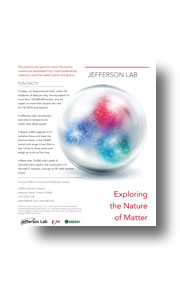JEFFERSON LAB SEARCH
-
Hall C is 150 feet in diameter and 60 feet tall.
Hall C is 150 feet in diameter and 60 feet tall. Hall C houses a High Momentum Spectrometer and has been used extensively for large-installation experiments. These are stand-alone experiments requiring unique or highly specialized detectors, magnets and targeting systems. Experiments run in Hall C have covered a broad spectrum of topics, including the structure of pions, kaon particle production, excited states of the proton, and duality.
-
It is equipped with the CEBAF Large Acceptance Spectrometer, or CLAS, which is shaped like an elongated sphere.
Hall B is the smallest of Jefferson Lab's three experimental halls. It is 98 feet in diameter and 65 feet from floor to ceiling. It is equipped with the CEBAF Large Acceptance Spectrometer, or CLAS, which is shaped like an elongated sphere. Experiments in this hall can receive electron beam or a photon beam. A major research program in Hall B has been the investigation of the quark-gluon structure of protons and neutrons and a detailed study of excited states.
-
Hall A is the largest of Jefferson Lab's three experimental halls.
Hall A is the largest of Jefferson Lab's three experimental halls. It is 174 feet across and 80 feet tall from floor to ceiling. Hall A is outfitted with two primary detector systems – both high-resolution spectrometers and each weighing about 450 tons. The systems act like huge microscopes, allowing scientists to "see" inside an atom. Hall A is used primarily for experiments that study the structure of nuclei, and of protons and neutrons.
-
A recording of the Theory Seminar on November 13th, 2023.
A talk by Xiang Gao of Argonne National Lab.
-
They Scatter Neutrinos, Don't They?
Despite the crushing difficulty of using neutrinos as a probe, neutrino scattering experiments in the US and Japan have recently benefited from ever more intense neutrino beams, new schemes for building cost-effective, large, capable detectors, and dogged determination to run long enough to complete a thousand marathons. I’ll discuss recent some results and techniques, with a focus on the MINERvA experiment at Fermilab.
-
A recording of the Theory Seminar given by Ferenc Pittler on Dec 11th, 2023.
A talk by Ferenc Pittle
-
A recording of the Theory Seminar given by Dominik Stamen of Bonn University on March 4th.
A presentation by Dominik Stamen (Bonn University).
-
A recording of the Theory Seminar given by Martin Schvellinger of Instituto de Física La Plata on March 25th.
A presentation by Martin Schvellinger (Instituto de Física La Plata, CONICET-UNLP, Argentina).
-
A recording of the Theory Seminar given by Yannick Ulrich of University of Bern on April 1st.
A presentation by Yannick Ulrich (University of Bern).


